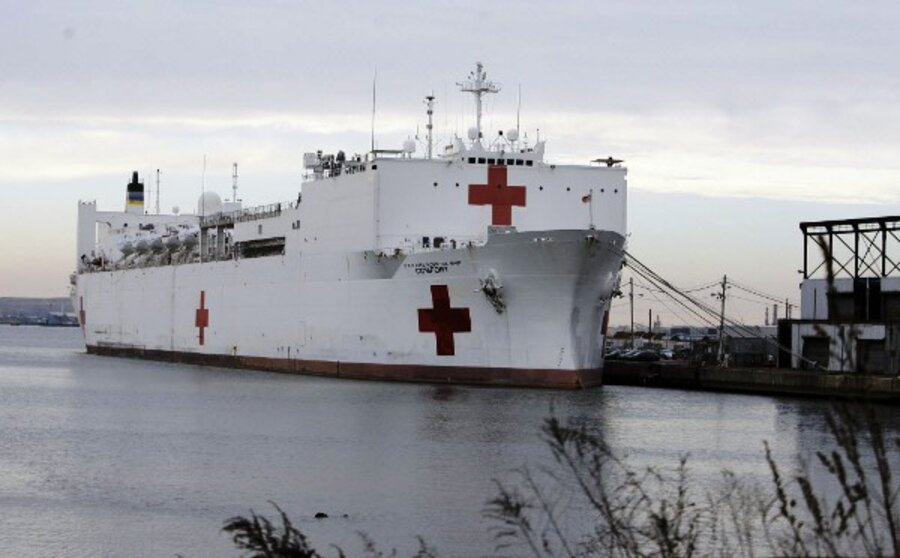Pentagon defends response time of Haiti aid efforts
Loading...
| Washington
Defense Secretary Robert Gates says the initial response time of the US government to the disaster in Haiti was about as good as it can be.
Mr. Gates said earthquake relief was the first priority of the American military “in this hemisphere” as military jets begin routine deliveries of relief supplies and the aircraft carrier USS Carl Vinson arrives, three days after the 7.0 magnitude earthquake rocked the impoverished country.
“I don’t know how this government could have responded faster or more comprehensively than it has,” Gates said at the Pentagon Friday. “There are just some certain facts of life that affect how quickly you can do some of these things.”
Katrina relief commander says US could do better
But retired Army Lt. Gen. Russel Honoré, who served as the task force commander for relief efforts following Hurricane Katrina in 2005, said Thursday evening in an interview that he believes the American government could do better.
“I thought we had learned that from Katrina, take food and water and start evacuating people,” Honoré says. “I think this will get better over the next couple days, but I thought we could have had a faster start.”
The initial Defense Department response on Wednesday seemed to be focused on making initial assessments, instead of getting relief supplies and personnel on the ground. Local search and rescue teams, including one from Virginia and another from California, were able to get on the ground relatively quickly and begin using their equipment to pull people from fallen buildings and debris.
Aid from China arrived before US
Contributions from other countries, such as China, arrived earlier than the US. The media were also able to get there quickly and provide some of the first images of the disaster.
“It’s astonishing to me that the media can beat the US military in there,” Honoré says. He said he believes that the American government’s bureaucracy still stands in the way and that it must be changed to allow the Defense Department to act quicker instead of getting entangled in red tape.
But other disaster relief experts say the US military has responded as quickly as possible, and that those initial assessments are critical to responding effectively.
“These situations are always complex,” says Mark Ghilarducci, a vice president at James Lee Witt Associates, founded by a former director of the Federal Emergency Management (FEMA) under President Clinton in the 1990s. The firm may do work for the US government in Haiti.
“You need to know what are the best resources to apply because you know you’re going into one of the most chaotic situations there,” says Mr. Ghilarducci
Ghilarducci says the US military’s response has been reasonably good, but he recognizes that fast is never fast enough in the face of such devastation.
Medical personnel and supplies are on the Carl Vinson and other ships expected to arrive in Haiti Friday and over the weekend. The Navy has two hospital ships which would seem ideal for the mounting number of casualties – expected to be in the tens of thousands.
US Navy hospital ship will take a week
But the USNS Comfort hospital ship won’t arrive until late next week. The Comfort, which has 250 hospital beds and 12 operating rooms, is an older ship which typically sits in “mothball” status in the Port of Baltimore. The ship has been manned and will soon begin steaming to Haiti, but it won’t get there until long after the “golden hour” of relief is needed.
Some of these challenges are unavoidable.
“In all these things we’ll learn lessons, and some of that is readiness clearly tied to something like this,” said Adm. Mike Mullen, chairman of the Joint Chiefs of Staff, who flanked Gates at Friday’s press briefing. “But certainly after this point, I’m comfortable that we’ve got that cycle about right.”
Gates pointed to the infrastructure in Haiti – already in poor shape – that has been largely decimated by the quake. This includes port facilities and the airport in Port-au-Prince, Haiti's capital, which is serving as the primary entry point for relief supplies and personnel. Parachute drops, which would seem to provide quake victims with the most immediate relief, have been ruled out for now out of fear that they could cause rioting.
“Without any structure for distribution or to provide security when things become available, then it seems to me that’s a formula for contributing to chaos rather than preventing it,” Gates said.
The US is sending a total of about 9,000 personnel to Haiti, but the bulk of those troops, including about 2,200 marines, will stay aboard ships until needed. A brigade of the Army’s 82nd Airborne Division, Fort Bragg, N.C., will be on the ground by the end of the weekend, defense officials say.
-----
Follow us on Twitter.





